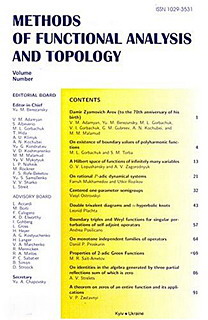O. P. Boyko
Search this author in Google Scholar
On the second largest multiplicity of eigenvalues for the Stieltjes string spectral problem on trees
Olga Boyko, Olga Martynyuk, Vyacheslav Pivovarchik
MFAT 27 (2021), no. 3, 217-226
217-226
The largest possible multiplicity of an eigenvalue of a spectral
problem generated by the Stieltjes string equations on a metric tree
is $p_{pen}-1$, where $p_{pen}$ is the number of pendant
vertices. We propose how to find the second largest possible
multiplicity of an eigenvalue of such a problem. This multiplicity
depends on the numbers of point masses on the edges of the trees.
Максимально можлива кратність власного значення спектральної задачі,
породженої рівняннями струни Стілтьєса на метричному дереві,
дорівнює $p_{pen}-1$, де $p_{pen}$ — кількість висячих вершин. Ми
пропонуємо, як знайти другу за величиною кратність власного значення
такої задачі. Ця кратність залежить від кількості точкових мас на
ребрах дерев.
On maximal multiplicity of eigenvalues of finite-dimensional spectral problem on a graph
Olga Boiko, Olga Martynyuk, Vyacheslav Pivovarchik
MFAT 25 (2019), no. 2, 104-117
104-117
Recurrence relations of the second order on the edges of a metric connected graph together with boundary and matching conditions at the vertices generate a spectral problem for a self-adjoint finite-dimensional operator. This spectral problem describes small transverse vibrations of a graph of Stieltjes strings. It is shown that if the graph is cyclically connected and the number of masses on each edge is not less than 3 then the maximal multiplicity of an eigenvalue is $\mu+1$ where $\mu$ is the cyclomatic number of the graph. If the graph is not cyclically connected and each edge of it bears at least one point mass then the maximal multiplicity of an eigenvalue is expressed via $\mu$, the number of edges and the number of interior vertices in the tree obtained by contracting all the cycles of the graph into vertices.
On a generalization of the three spectral inverse problem
O. P. Boyko, O. M. Martynyuk, V. N. Pivovarchik
MFAT 22 (2016), no. 1, 74-80
74-80
We consider a generalization of the three spectral inverse problem, that is, for given spectrum of the Dirichlet-Dirichlet problem (the Sturm-Liouville problem with Dirichlet conditions at both ends) on the whole interval $[0,a]$, parts of spectra of the Dirichlet-Neumann and Dirichlet-Dirichlet problems on $[0,a/2]$ and parts of spectra of the Dirichlet-Newman and Dirichlet-Dirichlet problems on $[a/2,a]$, we find the potential of the Sturm-Liouville equation.
Inverse spectral problem for a star graph of Stieltjes strings
MFAT 14 (2008), no. 2, 159-167
159-167
We solve the inverse spectral problem for a star graph of Stieltjes strings (these are threads bearing a finite number of point masses) with the pendant ends fixed, i.e., we recover the masses and lengths of the intervals between them from the spectra of small transverse vibrations of the graph together with the spectra of the Dirichlet problems on the edges and the total lengths of the edges.
Inverse problem for Stieltjes string damped at one end
Olga Boyko, Vyacheslav Pivovarchik
MFAT 14 (2008), no. 1, 10-19
10-19
Small transversal vibrations of the Stieltjes string, i.e., an elastic thread bearing point masses is considered for the case of one end being fixed and the other end moving with viscous friction in the direction orthogonal to the equilibrium position of the string. The inverse problem of recovering the masses, the lengths of subintervals and the coefficient of damping by the spectrum of vibrations of such a string and its total length is solved.

